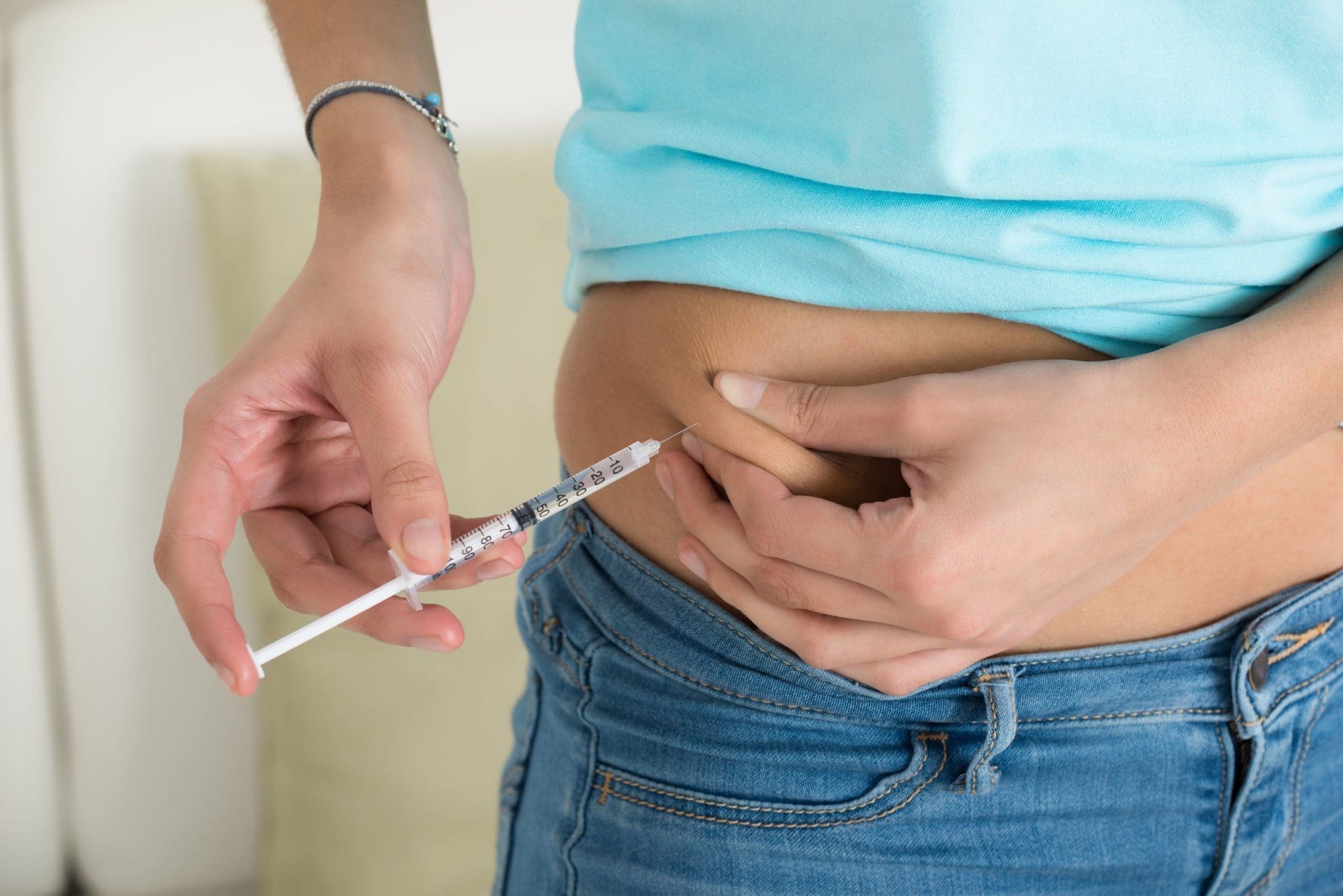When you digest food, your body changes most of the food you eat into glucose (a type of sugar). Insulin allows this glucose to enter all of the cells in your body and be used for energy. When you have diabetes, your body either doesn’t make enough insulin or can’t use it properly. Because of this, glucose builds up in your blood instead of moving into your cells. Too much glucose in your blood and not enough in your cells can lead to serious health problems.
Everyone with type 1 diabetes and some people with type 2 diabetes need to take insulin. It helps control blood sugar levels. The goal is to keep blood sugar within a normal range as much as possible. Insulin is usually given by injection. It can also be given with a pen or pump.
Path to better health
How often will I need to take insulin?
You and your doctor will come up with a schedule that’s right for you. Most people who have diabetes and take insulin need at least two injections a day to control their blood sugar well. Some people need three or four injections a day.
Do I need to monitor my blood sugar?
Yes. Monitoring and controlling your blood sugar is critical to preventing diabetes complications. If you are not already controlling your blood sugar, you will need to learn how to do so. To monitor your blood sugar, you prick your finger to obtain a small drop of blood that is placed on a test strip. The strip is then inserted into a machine called a glucose meter. The results will tell you if your blood sugar is within a healthy range.
There are newer devices that allow you to monitor your blood sugar level without pricking your finger. Some of these work by placing a sensor on your arm or abdomen. The sensor reads the glucose levels in the fluids just under your skin. The information is transmitted to a reader or to an app on your phone.
Your doctor will help you decide which method is best for you.
When should I take insulin?
You and your doctor should talk about when and how you will take your insulin. Each person’s treatment is different. Some people who use regular insulin take it 30 to 60 minutes before a meal. Some people who use rapid-acting insulin take it just before eating.
Types of insulin:
- Rapid-acting insulin (such as insulin lispro, insulin aspart, and insulin glulisine) start working in about 15 minutes and last for 3 to 5 hours.
- Short-acting insulin (like regular insulin) starts working in 30 to 60 minutes and its effect lasts for 5 to 8 hours.
- Intermediate-acting insulin (such as NPH insulin) starts working in 1 to 3 hours and lasts 12 to 16 hours.
- Long-acting insulin (such as insulin glargine and insulin detemir) start working in about 1 hour and last for 20 to 26 hours.
- Premixed insulin It is a combination of two types of insulin (usually a rapid- or short-acting insulin and an intermediate-acting insulin).
What is rapid-acting insulin? How can it help me control my blood sugar?
Rapid-acting insulin starts working more quickly than other types of insulin. It starts working within 15 minutes and is eliminated from the body after 3 to 5 hours.
To keep your blood sugar level stable throughout the day, your doctor may also prescribe a long-acting insulin, or he or she may prescribe another medicine for you to take every day in addition to your rapid-acting insulin.
When should I take rapid-acting insulin?
You should inject rapid-acting insulin no more than 15 minutes before eating. Your doctor will tell you how much insulin to inject. Remember, you should not wait more than 15 minutes to eat after receiving this insulin injection.
Rapid-acting insulin may be more convenient to take than regular insulin. With regular insulin, you inject the insulin and wait 30 to 60 minutes before eating. Many people find it difficult to time their meals around regular insulin injections. Sometimes, they end up eating too early or too late, and don’t have the best control of their blood sugar. Because rapid-acting insulin is given so close to mealtime, it can help you control your blood sugar more effectively.
Can I mix rapid-acting insulin with other types of insulin?
You can mix a rapid-acting insulin with an intermediate-acting insulin, as instructed by your doctor. The rapid-acting insulin should always be drawn into the syringe first. This will prevent the intermediate-acting insulin from entering the rapid-acting insulin bottle. After mixing the rapid-acting insulin in the same syringe with an intermediate-acting insulin, you should inject the mixture under your skin within 15 minutes. Remember to eat within 15 minutes of the injection.
How do I prepare the correct dose of insulin?
You can give yourself insulin with a syringe that is filled from a vial or with a dosing pen that contains the insulin. If your rapid-acting insulin comes in a pen, your doctor or his or her office staff can show you how to use it correctly. Follow the instructions carefully.
- Wash your hands.
- Remove the plastic cap from the new insulin bottle. Wipe the top of the bottle with a cotton swab dipped in rubbing alcohol. It is best to allow rapid-acting insulin to reach room temperature before injecting.
- Pull back on the syringe plunger. This will draw air into the syringe equal to the dose of insulin you are taking. Then insert the syringe needle through the rubber cap of the insulin bottle. Inject air into the bottle by pushing the syringe plunger forward. Then turn the bottle upside down.
- Make sure the tip of the needle is in the insulin. Pull back the plunger on the syringe to draw up the correct dose of insulin. The insulin dose is measured in units.
- Make sure there are no air bubbles in the syringe before removing the needle from the insulin bottle. Air bubbles can reduce the amount of insulin you receive in the injection. If there are air bubbles, hold the syringe and bottle upright with one hand, tap the syringe with your other hand and let the air bubbles rise to the top. Press the syringe plunger to force the air bubbles back into the insulin bottle. Then draw up the correct dose of insulin by pulling the plunger back.
- Clean your skin with a cotton swab dipped in alcohol. Grab a fold of skin and inject the insulin at a 90-degree angle. (If you are thin, you may need to pinch the skin and inject the insulin at a 45-degree angle.) Once the needle is in your skin, you do not need to pull back on the syringe plunger to check for blood.
Where do I inject insulin?
Insulin is injected just under the skin. Your doctor or his or her office staff will show you how and where to give an insulin injection. Common places to inject insulin are the upper arm, the front and sides of the thighs, and the abdomen. Do not inject insulin closer than 2 inches (5 cm) to the belly button.
To prevent the skin from thickening, try not to inject insulin in the same place over and over. Instead, rotate injection sites.
Things to keep in mind
If you are going to use rapid-acting insulin, you should be aware of insulin reactions and how to deal with them. Rapid-acting insulin starts working very quickly, so while you and your doctor work to find the right dose of this insulin, you may have some insulin reactions.
Hypoglycemia is a condition in which your blood sugar level is too low. If you take insulin, your blood sugar level can get too low if you exercise more than usual or if you don’t eat enough. It can also get too low if you don’t eat on time or if you take too much insulin. Most people who take insulin have insulin reactions at some point. Signs of an insulin reaction and hypoglycemia include:
- I feel very tired
- Yawn frequently
- Being unable to speak or think clearly
- Loss of muscle coordination
- Perspiration
- Spasms
- Having a seizure
- Suddenly, you feel like you’re going to faint.
- Getting very pale
- Losing consciousness
People with diabetes should carry at least 15 grams of a fast-acting carbohydrate with them at all times, in case of hypoglycemia or an insulin reaction. The following are examples of quick sources of energy that can relieve the symptoms of an insulin reaction:
- Non-diet soda: ½ to ¾ cup
- Fruit juice: ½ cup
- Fruit: 2 tablespoons of raisins
- Milk: 1 cup
- Sweets: 5 lifesavers
- Glucose tablets: 3 tablets (5 grams each)
If you don’t feel better 15 minutes after eating a fast-acting carbohydrate, or if monitoring shows your blood sugar is still too low, eat another 15 grams of a fast-acting carbohydrate.
Teach your friends, coworkers, and family members how to treat hypoglycemia, because sometimes you may need their help. Also, keep a supply of glucagon on hand. Glucagon comes in a kit with a powder and a liquid that you mix and then inject. It will raise your blood sugar level. If you are unconscious or unable to eat or drink, someone else can give you a glucagon injection. Talk to your doctor about when and how to use glucagon.
You should check your blood sugar regularly with a glucometer. Your doctor or his or her office staff can teach you how to use the glucometer. You will need to write down each measurement and show this record to your doctor. He or she will use this information to decide what amount of insulin is right for you.
Blood sugar readings can vary depending on your lifestyle. Stress levels, how often you exercise, and how quickly your body absorbs food can all affect readings. Hormonal changes related to puberty, menstrual cycles, and pregnancy can also affect them. An illness, travel, or change in your routine may mean you need to check your blood sugar more often.
Questions for your doctor
- Do I need insulin to control my type of diabetes?
- What type of insulin should I take?
- How often should I check my blood sugar?
- How do I know how much insulin I should take?
- What if insulin doesn’t seem to lower my blood sugar?
- What should I do to prevent my insulin levels from dropping too low at night?
Resources
National Institutes of Health, MedlinePlus: Insulin Injection







